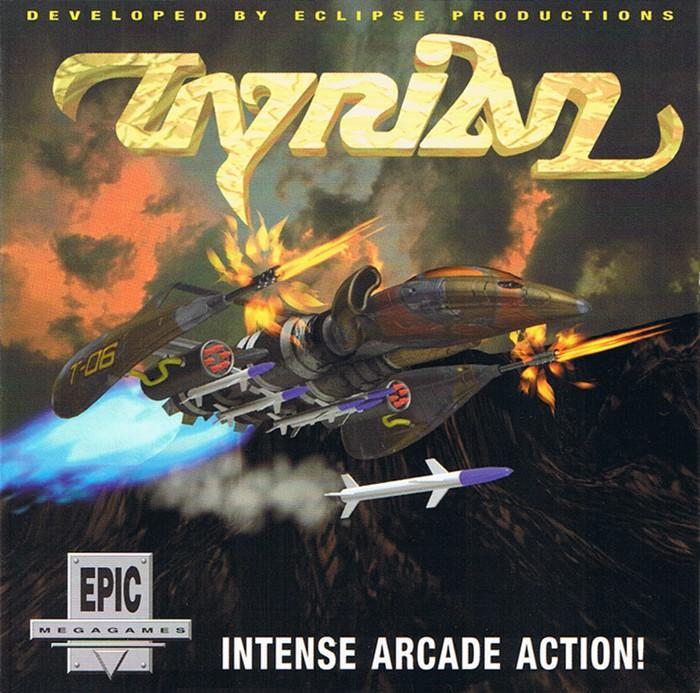Tyrian is another game from the shareware freeloading period of my childhood. Published by Epic Megagames, it frequently found space on my hard drive as one of the few shoot ‘em ups that I found myself coming back to over time. Unlike Major Stryker, Stargunner, or Raptor, Tyrian had something that drove me to replay it. I’m mainly going to talk about the “full story mode” here, as that’s what consumed most of my time. In that context, I think the appeal of Tyrian to me boils down to three things: forgiving gameplay, customizability, and storyline.
In terms of forgiving gameplay, Tyrian accomplishes that through two means: save slots between levels, and allowing you to take hits without restarting. Save slots are actually a minor thing compared to the way in which the game allows you to take hits, but it’s important when compared to previous arcade-style shmups that were difficult to complete because you had to do them all in one sitting. More importantly, Tyrian gave you recharging shields and an armor bar that had to be depleted before you died. Recharging shields meant that after you took some hits, you could potentially recover by playing more conservatively until they came back. This was further inflected by the fact that your shields drew from the same power source as your weapons, meaning that if you had a weak generator you might have to stop firing in order to allow your shields to recover. In retrospect, this is very similar the shield/health system popularized by Halo, and I find it a bit surprising that it took so long for First Person Shooters to pick up on that mechanic, since it works very well in a game where you can actually retreat or seek cover. At any rate, I preferred this system to the usual extra lives mechanic in shmups because it didn’t involve a break in the action any time I messed up. Instead of having to pause for a few seconds while I wait to respawn and go through a brief period of invincibility, I could simply keep playing and try to adjust my course to avoid suffering worse damage.
Customization is where Tyrian really stood out from other games in the genre. The game allowed you to use points earned by destroying enemies and picking up bonus drops to purchase and upgrade a variety of weapons for your ship as well as to acquire straightforward numerical upgrades (such as more armor, better shields, more powerful generators, etc.). Significantly, the game allowed you to sell back purchased weapons and upgrades at exactly the same price at which you acquired them. This meant there was no risk involved in picking and upgrading a weapon; if you discovered you didn’t like it, you could easily replace it after the next level without losing any buying power. Experimentation was thus tacitly encouraged by the lack of risk combined with the sheer variety of weapons available, and if some of them turned out to be rather useless, it was no big deal. Though I have to admit, it was something of a misstep for the Sonic Wave weapon to be a clear front-runner in the rear weapons category and so commonly available for the first level. On many playthroughs it was the only rear weapon I’d use, because it combined excellent firing arcs with the ability to contribute directly to your forward firepower.
Storyline is a bit of an odd duck to talk about with regards to Tyrian. It’s mainly remarkable that the game has one at all, but the way it is transmitted is also interesting. Storyline tidbits are read between levels, and acquired by picking up “data cubes” that drop as power-ups while shooting enemies. The bits you get to read are based on how many data cubes you acquired, as opposed to which specific drops you triggered, which allows the game to assure that significant information is easy to acquire, and makes ancillary tidbits a reward for playing well. The usual pattern is that the first cube will tell you why you are going to your next destination and a bit about who your enemies are. The second cube gives you world information about your next destination and may provide small hints about what to expect from the next level. Third and subsequent cubes are often jokes or references to other games that have nothing to do with anything. There’s nothing essential about the game’s storyline–you can easily play it as your average context-less shmup–but I like that the data cubes provide some basic explanation for the weird enemies you fight and varied terrain you fly over.
Like with all of the games I’ve talked about in this series, there’s a heft nostalgia component to my perception of this game that shouldn’t be discounted. But I think it says something that I’ve played Tyrian so much despite shmups not being a mainstay genre in my gaming habits. I likely would not play a new game similar to it today, but it hit at the right point in my childhood to make an impression. Also, it has a fantastic soundtrack.





